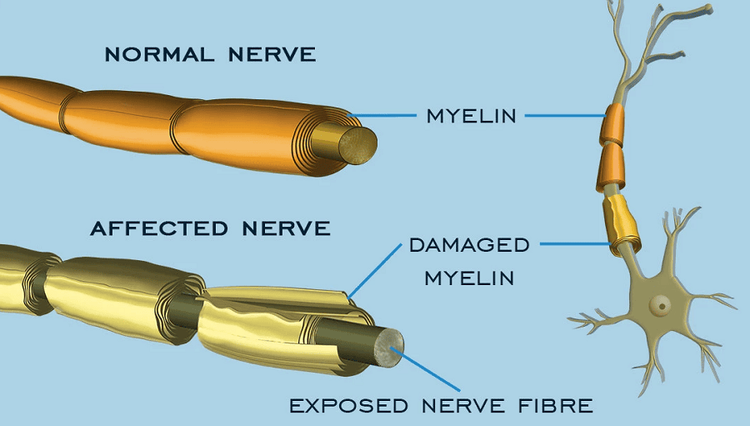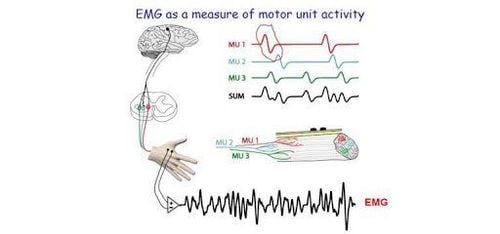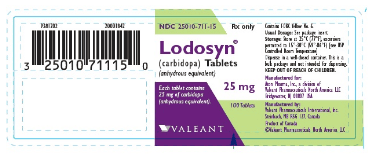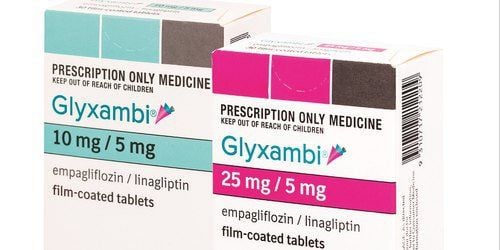This is an automatically translated article.
The article was professionally consulted by MSc Huynh An Thien - Department of Medical Examination and Internal Medicine, Vinmec Danang International General Hospital.Guillain-Barre syndrome is a rare, rapidly progressive disorder that can have serious consequences for patients. Most patients will recover from Guillain-Barre syndrome, but some people will experience sequelae, such as muscle weakness, numbness, and fatigue.
1. What is Guillain-Barre Syndrome?
Guillain-Barre syndrome is a rare disorder in which the immune system attacks the body's own nerves. Muscle weakness and paresthesias of the extremities are often the first symptoms to appear.The above symptoms quickly spread, even paralyzing the whole body. In its most severe form, Guillain-Barre syndrome is an emergency. Patients with Guillain-Barre syndrome need to be hospitalized for treatment.
The exact cause of Guillain-Barre syndrome is unknown, but it usually begins after a bacterial infection such as a respiratory infection or viral gastroenteritis.
Currently, there is no complete cure for Guillain - Barre syndrome, but currently available treatments help relieve symptoms and shorten the duration of the disease. Most patients will recover from Guillain-Barre syndrome, but some people will experience sequelae, such as muscle weakness, numbness, and fatigue.

2. Symptoms of Guillain-Barre syndrome
Guillain-Barre syndrome usually begins with paresthesias and muscle weakness from the feet and legs spreading to the trunk and arms, but about half of patients present with symptoms in the arms or face. As Guillain-Barre syndrome progresses, muscle weakness may worsen to paralysis.Signs and symptoms of Guillain - Barre syndrome include:
A sharp, tingling sensation in the fingers, toes, ankles or wrists. Weakness in the legs spreading to the upper body. Unsteady walking, unable to climb stairs or even walking. Difficulty moving eyes or face, including speaking, chewing, or swallowing. Pain may be severe, and worsen at night. Possible bladder and bowel disorders. Fast heart beat. Low or high blood pressure. Shortness of breath. Symptoms of patients with Guillain-Barre syndrome usually progress to their maximum within two to four weeks of presentation.
3. Classification of Guillain-Barre syndrome
Guillain-Barre syndrome is not a single disorder, but rather a collection of different forms, including:Acute inflammatory demyelinating polyradiculoneuropathy (AIDP): most common, presenting as muscle weakness that begins in the lower body and then spreads upward. Miller Fisher syndrome (MFS): paralysis begins in the eyes, may appear unsteady walking. Acute motor axonal neuropathy (AMAN) and acute motor-sensory axonal neuropathy (AMSAN).
4. When to see a doctor?

Paresthesias appear from the toes or feet, then spread to the upper body. Paresthesias, muscle weakness spread very quickly. Shortness of breath when lying down. Choking when swallowing saliva. Guillain-Barre syndrome is a serious condition that requires urgent hospitalization because it progresses very quickly, so the sooner treatment is given, the better the prognosis.
5. Causes of Guillain-Barre Syndrome
The cause of Guillain-Barre syndrome is currently unknown. Usually Guillain-Barre syndrome occurs days or weeks after an episode of respiratory or gastrointestinal infection, and more rarely after surgery or vaccination. Recently there have been several reports of Guillain-Barre syndrome appearing after Zika virus infection.Risk factors for Guillain - Barre syndrome are:
Male, young. Campylobacter infection (most common). Viral infections: influenza, cytomegalo, Epstein - Barr, zika, hepatitis (A, B, C, E), HIV. Mycoplasma pneumoniae infection. Surgery. Hodgkin's disease. Vaccination (rare).
6. Complications of Guillain-Barre . syndrome
Guillain - Barre syndrome affects the nerves, so it can cause the following complications:Shortness of breath: weakness or paralysis of the muscles that can spread to the respiratory muscles and threaten the patient's life. Up to 30% of patients with Guillain-Barre syndrome require mechanical ventilation during their hospital stay. Sequelae of loss of sensation or paresthesia: most patients recover completely or have only mild sequelae (muscle weakness, loss of sensation, paresthesias). Cardiovascular problems: Fluctuating blood pressure and irregular heart rhythms are common in Guillain-Barre syndrome. Pain: half of patients with Guillain-Barre syndrome have severe neuropathic pain, which responds to analgesics. Bladder and colon dysfunction: constipation, urinary retention can be seen in Guillain - Barre syndrome. Thrombosis: Patients with complete paralysis due to Guillain-Barre syndrome face an increased risk of thrombosis. Pressure ulcers: Patients who lie down for a long time (because of paralysis) are prone to pressure ulcers. Regularly change the patient's position to limit this complication. Relapse: about 3% of patients have a relapse. Although rare, patients can still die from Guillain-Barre syndrome due to respiratory distress syndrome and myocardial infarction.
7. Diagnosis of Guillain-Barre syndrome
Guillain-Barre syndrome can be difficult to diagnose in its early stages, because early symptoms can also be present in other neurological conditions, and their appearance varies from patient to patient.For diagnosis, besides taking the history and clinical examination, the doctor may order:
Cerebrospinal fluid (CSF) : cerebrospinal fluid will be taken as a test to detect changes in the composition that are common in Guillain-Barre syndrome. Electromyogram: used to measure the patient's neuromuscular activity. Measure nerve conduction velocity.
8. Methods of treating Guillain-Barre syndrome
There is currently no complete cure for Guillain-Barre syndrome, but the following two treatments help speed recovery and reduce the severity of the disease:Plasmapheresis Immunotherapy Two The above methods are equally effective, however using both methods at the same time or in succession is not more beneficial than using only one.
During treatment, other drugs will also be prescribed such as pain relievers, drugs to prevent blood clots...
Patients with Guillain - Barre syndrome need physical therapy during the course of treatment. and in the recovery period.
9. Prognosis for Guillain-Barre syndrome
Although it can take years for some people to recover, for most patients with Guillain-Barre syndrome:After the first symptoms appear, the condition worsens over about two weeks, and reaches to a maximum of about four weeks. Begin the recovery process, which usually takes 6 to 12 months (although it can take up to 3 years for some people). Among adults recovering from Guillain-Barre syndrome:
Approximately 80% of patients are able to walk on their own after six months. About 60% of patients recover fully after one year. About 5 - 10% of patients recover very slowly or not completely. Children, although rare, Guillain-Barre syndrome, but if infected, it is often easier to make a full recovery than adults.
Master Doctor Huynh An Thien has strengths and experiences in examination, consultation and treatment of neurological diseases; respiratory and endocrine-metabolic diseases
Before being an Endocrinologist at the Department of Medical Examination and Internal Medicine - Vinmec International General Hospital Da Nang, Dr. Thien used to have long working experience at the hospital. Hue Central.
Please dial HOTLINE for more information or register for an appointment HERE. Download MyVinmec app to make appointments faster and to manage your bookings easily.
Article referenced source: mayoclinic.org













